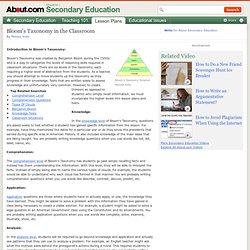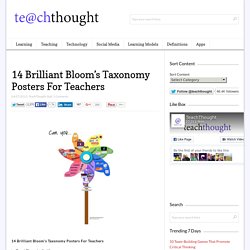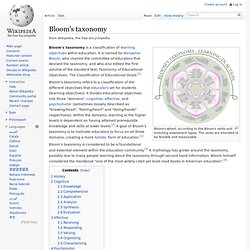

Www.uwec.edu/CETL/resources/upload/Blooms_digital.pdf. Lesson Plans and Tests Using Blooms Taxonomy. Introduction to Bloom's Taxonomy: Bloom's Taxonomy was created by Benjamin Bloom during the 1950s and is a way to categorize the levels of reasoning skills required in classroom situations.

There are six levels in the taxonomy, each requiring a higher level of abstraction from the students. As a teacher, you should attempt to move students up the taxonomy as they progress in their knowledge. Tests that are written solely to assess knowledge are unfortunately very common. However, to create thinkers as opposed to students who simply recall information, we must incorporate the higher levels into lesson plans and tests.
Knowledge: In the knowledge level of Bloom's Taxonomy, questions are asked solely to test whether a student has gained specific information from the lesson. Comprehension: The comprehension level of Bloom's Taxonomy has students go past simply recalling facts and instead has them understanding the information. Application: Analysis: Blooms_taxonomy.jpg (750×508) 14 Bloom's Taxonomy Posters For Teachers. 14 Brilliant Bloom’s Taxonomy Posters For Teachers by TeachThought Staff Bloom’s Taxonomy is a useful tool for assessment design, but using it only for that function is like using a race car to go to the grocery–a huge waste of potential.

In an upcoming post we’re going to look at better use of Bloom’s taxonomy in the classroom, but during research for that post it became interesting how many variations there are of the original work. While a handful of the charts below only show aesthetic changes compared to others, most are concept maps of sorts–with graphic design that signifies extended function (power verbs), detail (clear explanations), or features of some sort (Bloom’s Taxonomy tasks by level).
The follow simple, student-centered Bloom’s graphics were created by helloliteracy! Blooming Orange: Bloom's Taxonomy Helpful Verbs Poster. Here’s another poster to help get you thinking about how you can apply Bloom’s higher-order thinking skills with your children.

This poster shows the segments of an orange with each segment relating to a thinking skill and some helpful verbs to serve as prompts. While there are many more verbs that we could have added, we felt that including just seven in each segment would make them easier to remember (For more information, see Miller’s paper “The Magical Number Seven, Plus or Minus Two: Some Limits on Our Capacity for Processing Information.” We thought it would be interesting to depict the verbs in a circular form as opposed to a hierarchical list, given that these skills don’t often occur in isolation and are interconnected. We went through several concepts including a wheel, a pie, and an apple, but somehow the orange seemed to work best when we put everything together. For those of you who prefer it, we’ve also created a grayscale version of the poster.
Download the pdf’s here: Applying Bloom's Taxonomy. Bloom's Taxonomy of Cognitive Levels. Knowledge Recalling memorized information.

May involve remembering a wide range of material from specific facts to complete theories, but all that is required is the bringing to mind of the appropriate information. Represents the lowest level of learning outcomes in the cognitive domain. Learning objectives at this level: know common terms, know specific facts, know methods and procedures, know basic concepts, know principles. Question verbs: Define, list, state, identify, label, name, who? [Top] Comprehension The ability to grasp the meaning of material. Learning objectives at this level: understand facts and principles, interpret verbal material, interpret charts and graphs, translate verbal material to mathematical formulae, estimate the future consequences implied in data, justify methods and procedures.
Www.clemson.edu/assessment/assessmentpractices/referencematerials/documents/Blooms Taxonomy Action Verbs. Bloom's taxonomy. Bloom's wheel, according to the Bloom's verbs and matching assessment types.

The verbs are intended to be feasible and measurable. Bloom's taxonomy is a classification of learning objectives within education. It is named for Benjamin Bloom, who chaired the committee of educators that devised the taxonomy, and who also edited the first volume of the standard text, Taxonomy of Educational Objectives: The Classification of Educational Goals. Bloom's taxonomy refers to a classification of the different objectives that educators set for students (learning objectives). It divides educational objectives into three "domains": cognitive, affective, and psychomotor (sometimes loosely described as "knowing/head", "feeling/heart" and "doing/hands" respectively). Bloom's taxonomy is considered to be a foundational and essential element within the education community.
History[edit] The first volume of the taxonomy, "Handbook I: Cognitive" (Bloom et al. 1956) was published in 1956. Cognitive[edit]